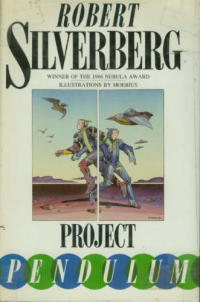The Secret Sharer by Robert Silverberg
 Wednesday, February 21, 2024 at 5:57AM
Wednesday, February 21, 2024 at 5:57AM 
First published in 1987; published in a limited edition by Subterranean Press on February 29, 2024
It’s been years since I read Joseph Conrad’s novella, The Secret Sharer. I recall it as the story of a stowaway who is discovered and concealed by the young ship’s captain. The captain feels an affinity with the hidden passenger. Robert Silverberg borrowed the broad outline of Conrad’s plot as well as the title for his 1987 novella. Subterranean Press is issuing the novella as a signed limited edition that might make a nice gift for Silverberg fans. Readers who don’t want to buy a limited edition can probably scour used book stores to pick up the novella in a collection of Silverberg’s best stories, but those readers will miss out on some cool illustrations.
The young captain in Silverberg’s story is named Adam. He is in charge of a starship. The ship is relatively frail, as Adam’s body will be after a long time away from planetary gravity. Neither the ship nor the captain can venture too near a planet.
The ship carries cargo and passengers to various destinations, where they are met by sturdier ships that ferry people and goods between the planet and the ship. Some passengers travel between stars in sleep chambers, while others leave their body behind and travel as a “matrix” that will be transferred to a new body.
Shortly after Adam’s first voyage begins, a matrix detaches from the grid that holds it. The matrix tries to enter a sleeping passenger but the passenger awakens and, in a panic, destroys the equipment that is keeping his body alive.
The matrix then makes contact with Adam. After telling him a sad story, she gains his permission to enter his body via a jack that allows the captain to plug into the ship. The matrix is the consciousness of a woman named Leeleaine, although she prefers the name Vox.
The other crew members are superstitious about the prospect of a loose matrix floating around the ship, particularly one who killed a passenger. They make efforts to capture it, placing Vox and the captain at risk. Can Vox return to the grid? Can she stay in Adam without being detected? Whether Vox will survive is the central question that gives the story its dramatic tension.
Silverberg has a long history of writing touching science fiction stories that are based on characterization rather than technology. Adam and Vox grow close to each other as they share a body. Both feel like outsiders who instantly understand each other. Both feel an intense loneliness when they are separated. That makes the novella something of a tragic love story. Silverberg creates sympathy for both characters and at least some measure of suspense before the story reaches a fitting resolution.
RECOMMENDED

